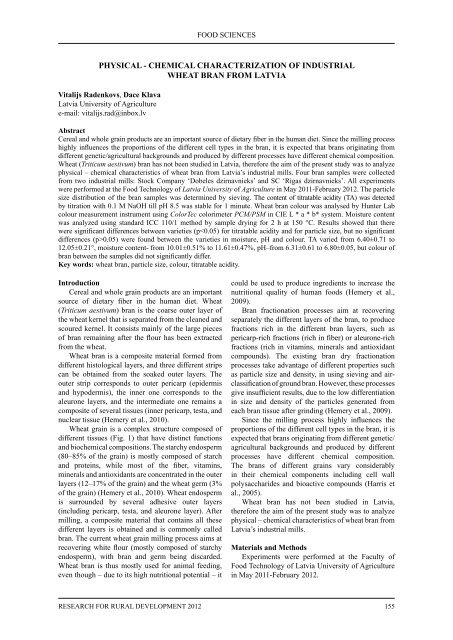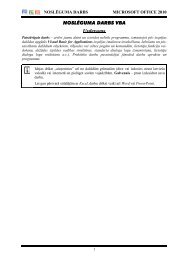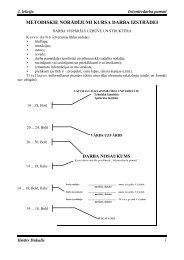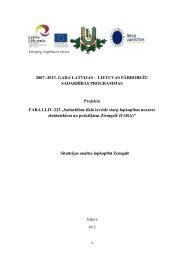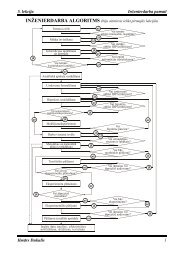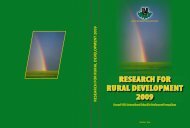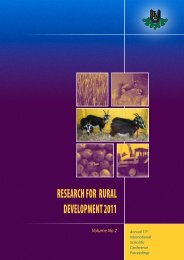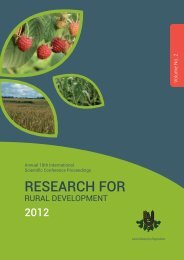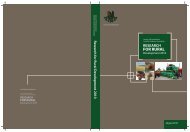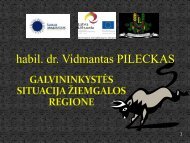LATVIA UNIVERSITY OF AGRICULTURE - Latvijas ...
LATVIA UNIVERSITY OF AGRICULTURE - Latvijas ...
LATVIA UNIVERSITY OF AGRICULTURE - Latvijas ...
- No tags were found...
Create successful ePaper yourself
Turn your PDF publications into a flip-book with our unique Google optimized e-Paper software.
FOOD SCIENCESPhysical - chemical CHARACTERIZATION of industrialwheat bran from <strong>LATVIA</strong>Vitalijs Radenkovs, Dace KlavaLatvia University of Agriculturee-mail: vitalijs.rad@inbox.lvAbstractCereal and whole grain products are an important source of dietary fiber in the human diet. Since the milling processhighly influences the proportions of the different cell types in the bran, it is expected that brans originating fromdifferent genetic/agricultural backgrounds and produced by different processes have different chemical composition.Wheat (Triticum aestivum) bran has not been studied in Latvia, therefore the aim of the present study was to analyzephysical – chemical characteristics of wheat bran from Latvia’s industrial mills. Four bran samples were collectedfrom two industrial mills: Stock Company ‘Dobeles dzirnavnieks’ and SC ‘Rigas dzirnavnieks’. All experimentswere performed at the Food Technology of Latvia University of Agriculture in May 2011-February 2012. The particlesize distribution of the bran samples was determined by sieving. The content of titratable acidity (TA) was detectedby titration with 0.1 M NaOH till pH 8.5 was stable for 1 minute. Wheat bran colour was analysed by Hunter Labcolour measurement instrument using ColorTec colorimeter PCM/PSM in CIE L * a * b* system. Moisture contentwas analyzed using standard ICC 110/1 method by sample drying for 2 h at 150 °C. Results showed that therewere significant differences between varieties (p0.05) were found between the varieties in moisture, pH and colour. TA varied from 6.40±0.71 to12.05±0.21°, moisture content- from 10.01±0.51% to 11.61±0.47%, pH–from 6.31±0.61 to 6.80±0.05, but colour ofbran between the samples did not significantly differ.Key words: wheat bran, particle size, colour, titratable acidity.IntroductionCereal and whole grain products are an importantsource of dietary fiber in the human diet. Wheat(Triticum aestivum) bran is the coarse outer layer ofthe wheat kernel that is separated from the cleaned andscoured kernel. It consists mainly of the large piecesof bran remaining after the flour has been extractedfrom the wheat.Wheat bran is a composite material formed fromdifferent histological layers, and three different stripscan be obtained from the soaked outer layers. Theouter strip corresponds to outer pericarp (epidermisand hypodermis), the inner one corresponds to thealeurone layers, and the intermediate one remains acomposite of several tissues (inner pericarp, testa, andnuclear tissue (Hemery et al., 2010).Wheat grain is a complex structure composed ofdifferent tissues (Fig. 1) that have distinct functionsand biochemical compositions. The starchy endosperm(80–85% of the grain) is mostly composed of starchand proteins, while most of the fiber, vitamins,minerals and antioxidants are concentrated in the outerlayers (12–17% of the grain) and the wheat germ (3%of the grain) (Hemery et al., 2010). Wheat endospermis surrounded by several adhesive outer layers(including pericarp, testa, and aleurone layer). Aftermilling, a composite material that contains all thesedifferent layers is obtained and is commonly calledbran. The current wheat grain milling process aims atrecovering white flour (mostly composed of starchyendosperm), with bran and germ being discarded.Wheat bran is thus mostly used for animal feeding,even though – due to its high nutritional potential – itcould be used to produce ingredients to increase thenutritional quality of human foods (Hemery et al.,2009).Bran fractionation processes aim at recoveringseparately the different layers of the bran, to producefractions rich in the different bran layers, such aspericarp-rich fractions (rich in fiber) or aleurone-richfractions (rich in vitamins, minerals and antioxidantcompounds). The existing bran dry fractionationprocesses take advantage of different properties suchas particle size and density, in using sieving and airclassificationof ground bran. However, these processesgive insufficient results, due to the low differentiationin size and density of the particles generated fromeach bran tissue after grinding (Hemery et al., 2009).Since the milling process highly influences theproportions of the different cell types in the bran, it isexpected that brans originating from different genetic/agricultural backgrounds and produced by differentprocesses have different chemical composition.The brans of different grains vary considerablyin their chemical components including cell wallpolysaccharides and bioactive compounds (Harris etal., 2005).Wheat bran has not been studied in Latvia,therefore the aim of the present study was to analyzephysical – chemical characteristics of wheat bran fromLatvia’s industrial mills.Materials and MethodsExperiments were performed at the Faculty ofFood Technology of Latvia University of Agriculturein May 2011-February 2012.Research for Rural Development 2012155


